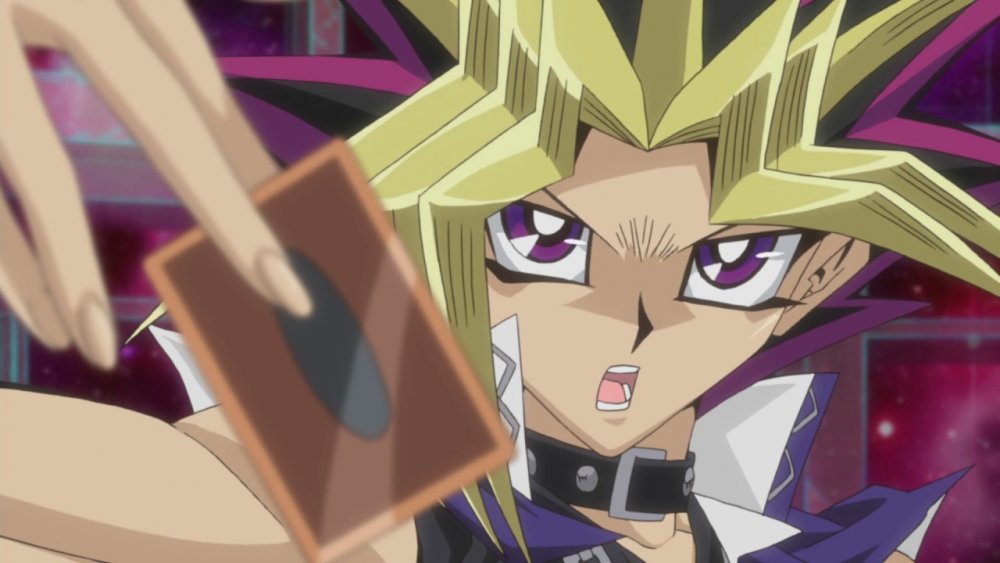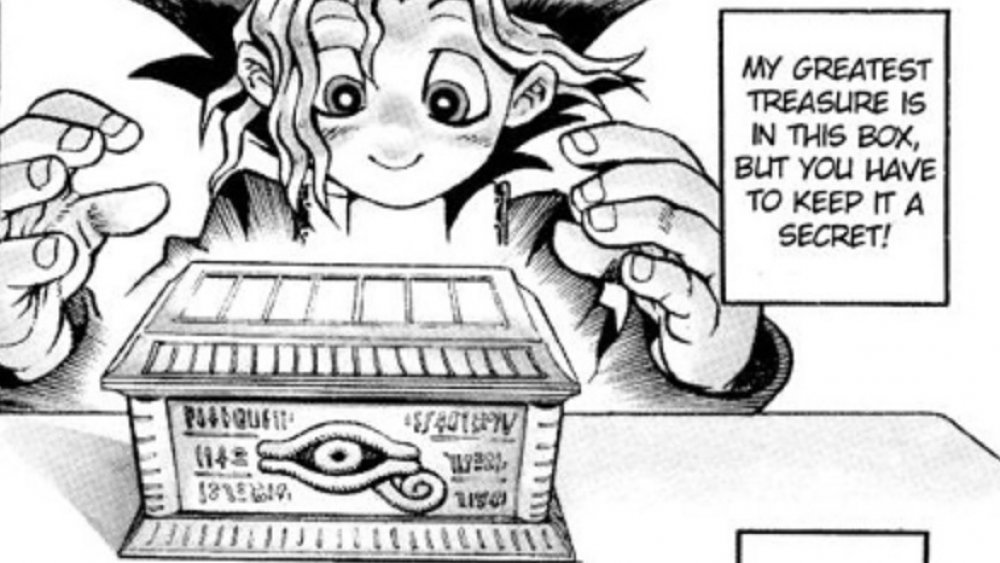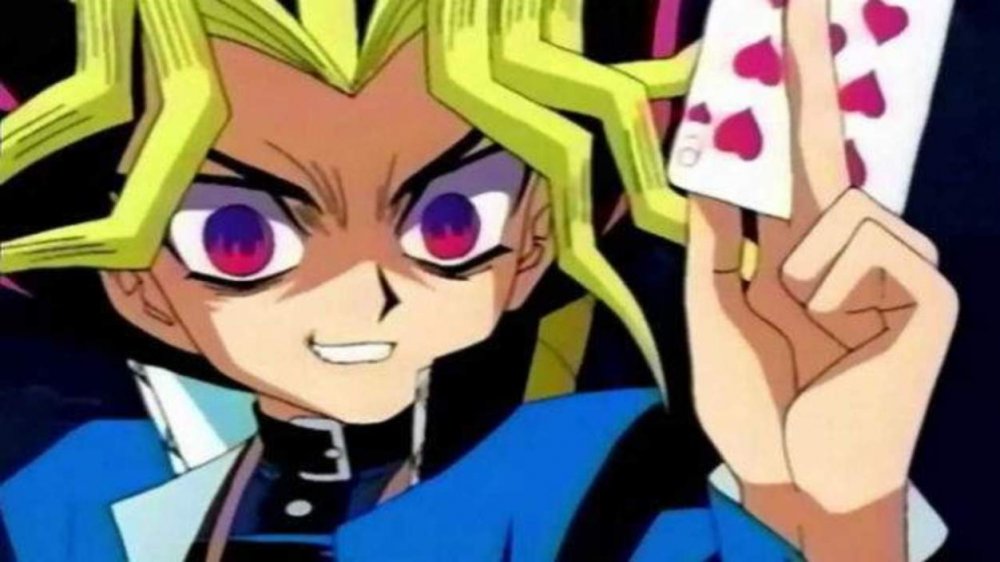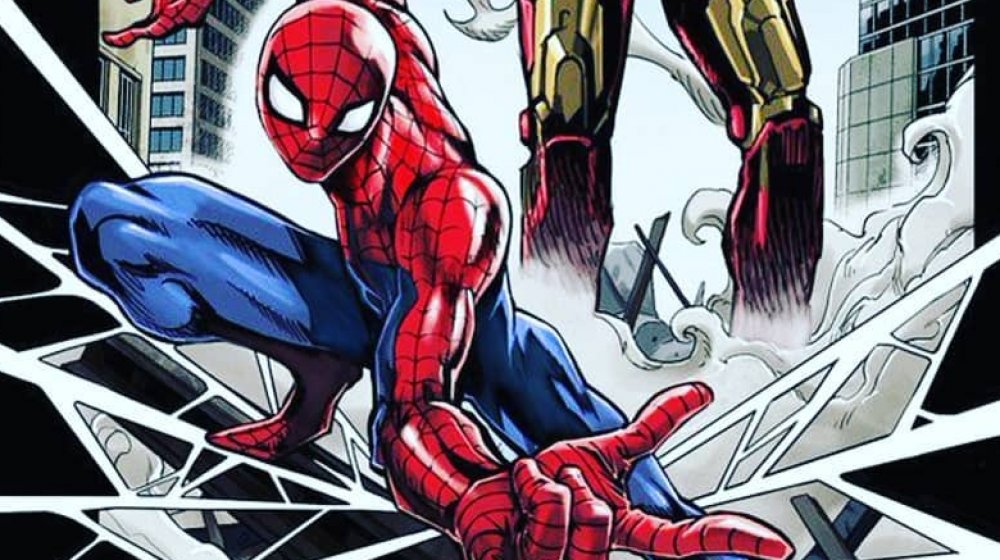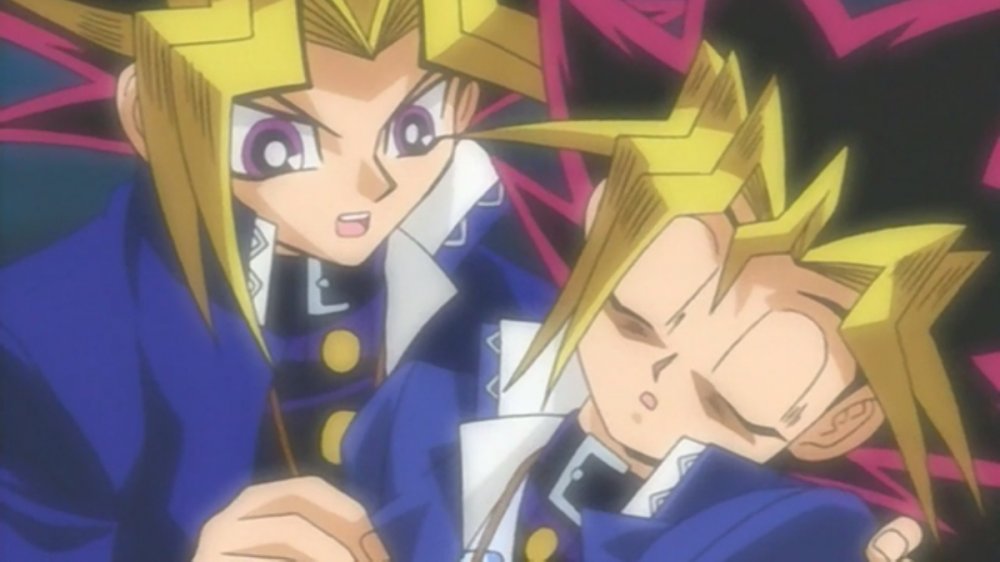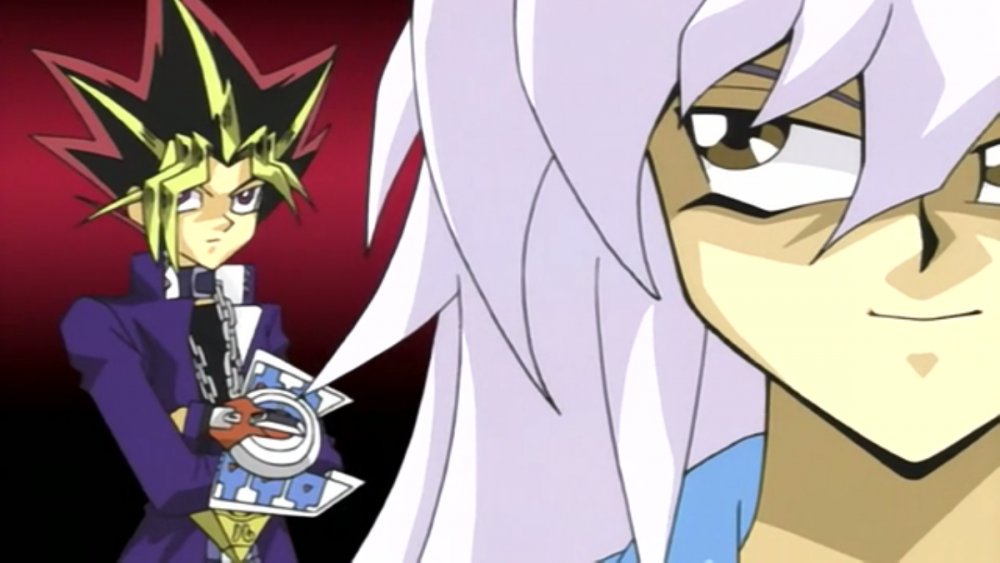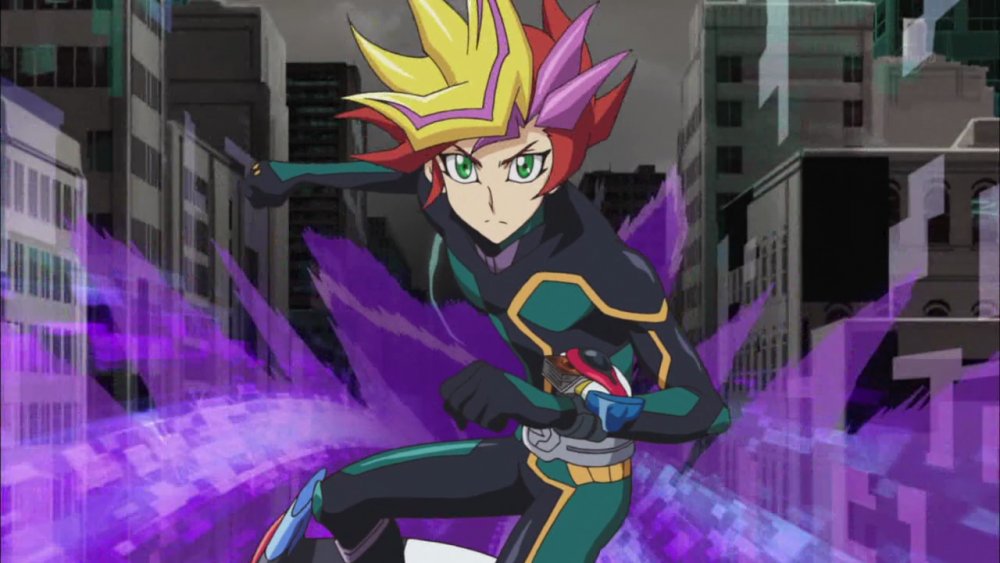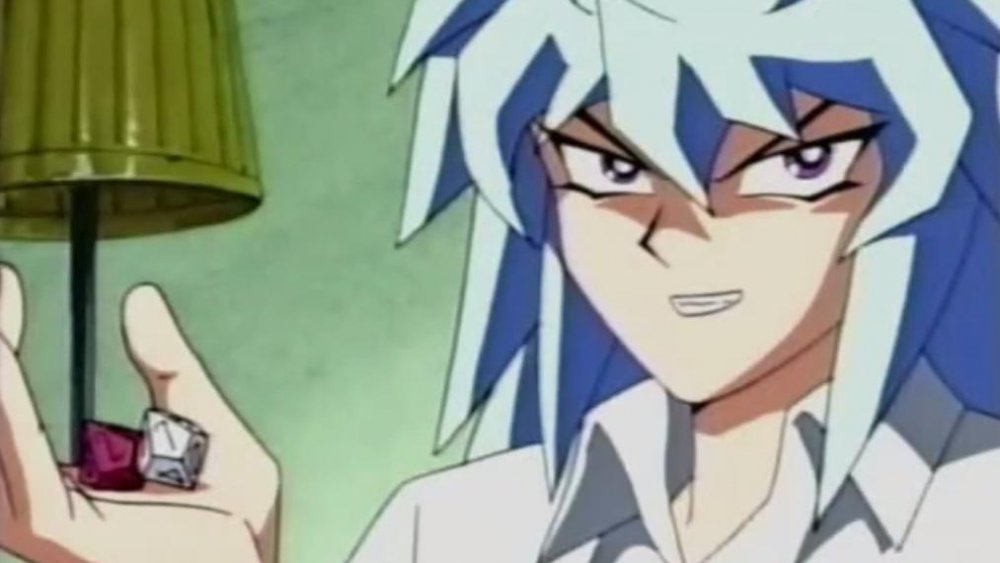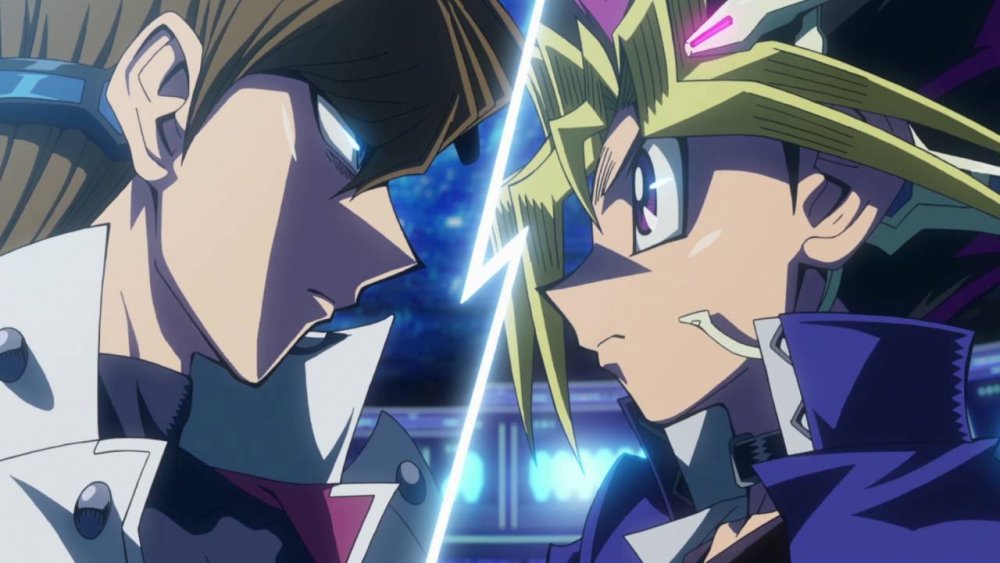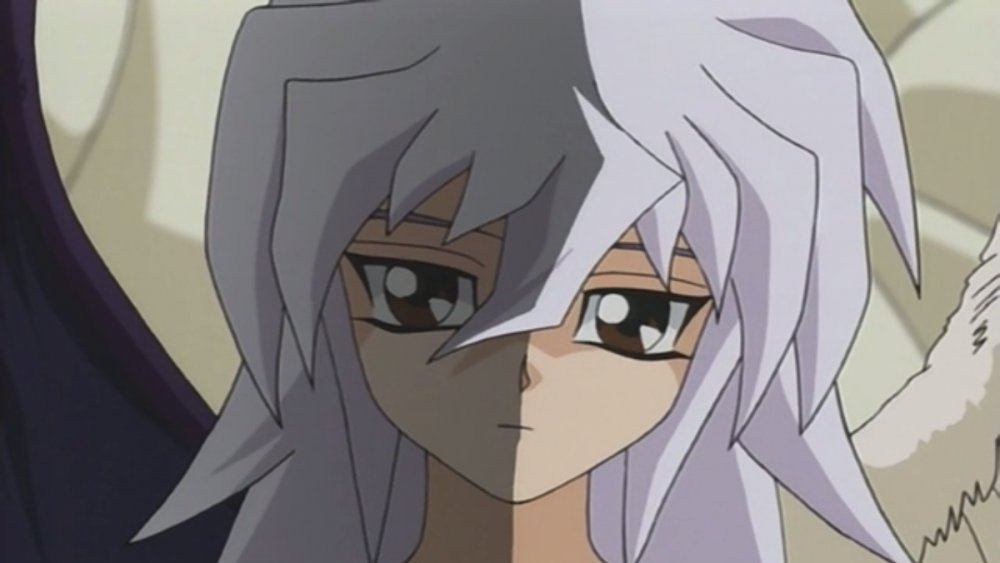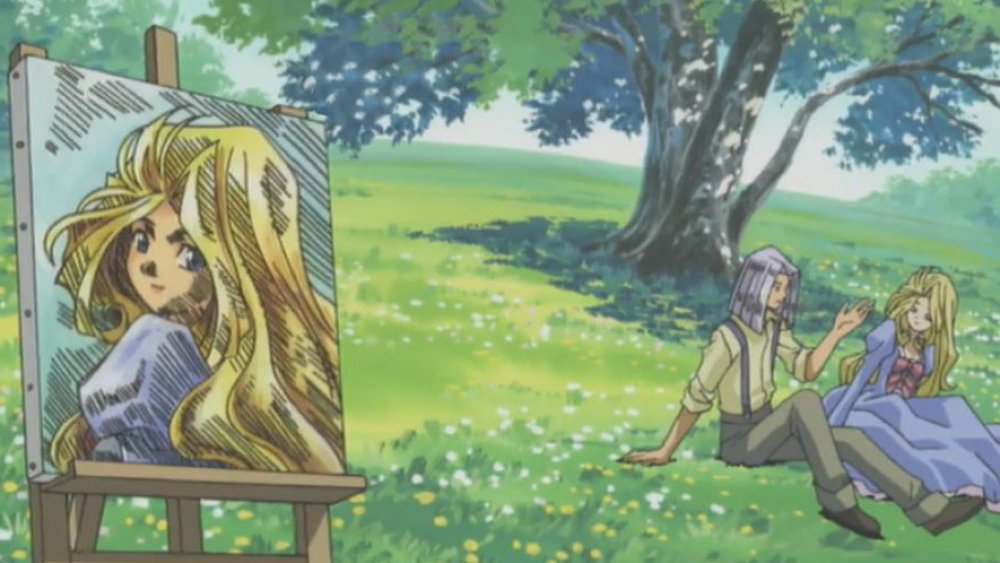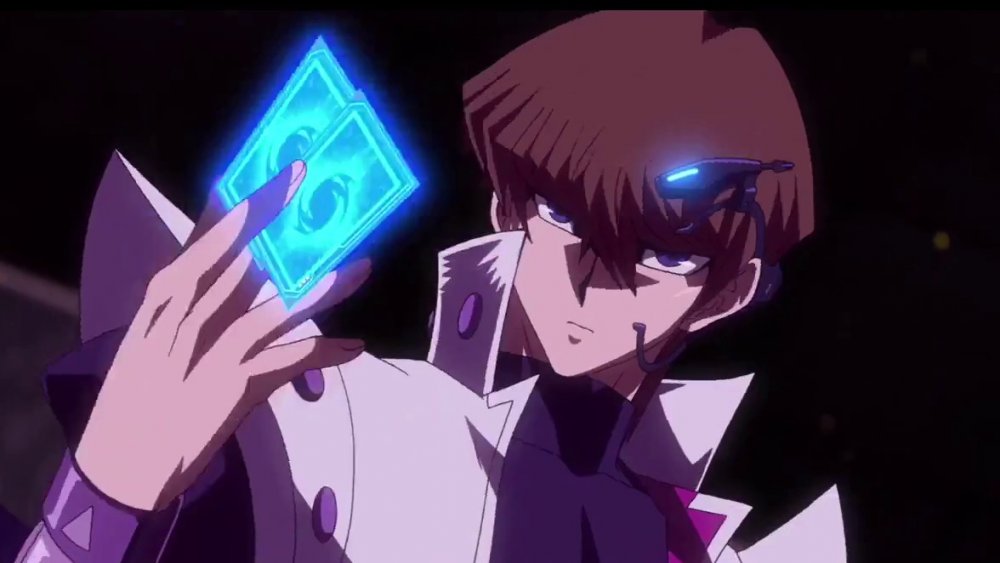The Untold Truth Of Yu-Gi-Oh!
Once upon a time, a duel meant pistols at dawn, with the duelists staking their lives on who was the quickest draw. Luckily, in the modern era we have a less bloody way to deal with disputes — instead of your life, you only have to sacrifice your life points.
Yu-Gi-Oh! was a foundational anime series for many, airing stateside in the early 2000s. With its combination of mystical ancient Egyptian lore, fast-paced game play, and the aggressive merchandising of a real-life trading card game, it was all the rage for a solid few years — and for some, it still holds a very special place in their hearts even years later. Whether you're a fan of the card game itself or you're in it for the story of restoring an ancient pharaoh's long-lost memories, there are plenty of little details from Yu-Gi-Oh! that casual fans could have easily missed. It's a long-running series with a surprising origin, one worthy of exploration — much like uncovering the mysteries of an ancient tomb.
Dark manga origins
Like many popular anime, Yu-Gi-Oh! started life as a manga, serialized in the popular manga magazine Weekly Shonen Jump. In this original manga, creator Kazuki Takahashi had a somewhat different vision for the series. Protagonist Yugi Muto (changed to Yugi Moto in the English dub) is a high school student who is often bullied for his short stature and nerdy obsession with games of various sorts. His grandfather, who owns a game shop, allows him to attempt to put together an ancient relic known as the Millennium Puzzle, which Yugi is able to achieve despite the fact that none have been able to before him.
This should all sound familiar to fans so far. Where the manga series takes a turn is that the alter ego that possesses Yugi after the Puzzle's completion hardly resembles the "Yami Yugi" most familiar to English-speaking audiences. Instead of an unwaveringly just game master, this dark entity metes out vigilante justice against bullies and criminals, going so far as to permanently disfigure, brainwash, or dispatch them. These early chapters of the manga don't focus just on the card game "Magic & Wizards," as it was originally known, but instead rotate between various diverse games of chance and skill. When an opponent challenges this dark Yugi, it's a bit like challenging Death to a game of chess, with impossible stakes and unsavory outcomes. This early Yu-Gi-Oh! is much more of a horror series than what it would become later in its serialization.
Season Zero
The anime series that is most popular in the Western world is not the only Yu-Gi-Oh! Anime. Before NAS and Studio Gallop had their go at making one of the most popular shonen anime of the 2000s, Toei Animation produced what has come to be known by some fans as "Season Zero." This late-'90s attempt has never had an official English-language release, unfortunately, but even Western fans are aware of how it differs from what the majority of us know as Yu-Gi-Oh!
Season Zero hews more closely to the manga's original story, exploring those dark themes of vigilante justice meted out by a cruel and savvy games master. It also sticks more closely to Takahashi's original art style, which in the early days was distinguished by his characters' cuter, more rounded features (even despite the horror and violence of the story itself). Since licensors have gone this long without attempting to license this initial anime adaptation, it doesn't seem likely that it will ever find its way into the North American market. Still, it's a nifty piece of the history of the series and its many iterations.
Kazuki Takahashi and Western comics
In the early manga and the original 1998 anime adaptation, there is a brief story about a character with a penchant for American superheroes. The chapters "American Hero" parts one and two, found in the third volume of the manga, follow Hanasaki, a classmate of Yugi's who is obsessed with the American superhero comic "Zombire."
Zombire definitely seems to be a bit of a spoof on the character Spawn, and it is clear from Takahashi's treatment of this episode that he has a good understanding of what the American comics landscape of the mid-'90s was like. In fact, he and comics creator Mike Mignola even did an art trade, swapping Yu-Gi-Oh! and Hellboy mash-up pieces, which were shared in the pages of Shonen Jump for the gratification of fans. More recently, Takahashi has provided the artwork for Japanese-only Marvel comics involving Spider-Man and Iron Man. It's clear, from all these instances as well as a good deal of his monster card designs, that Takahashi is a fan of Western comics, and influenced by them as much as he is by other manga. It would be a real treat for American fans of his work to get English-language versions of his Marvel works, and probably a lot of fun for him as well.
Lost in translation
Whenever something is translated for a different audience, things end up changing. That's normal and expected to a degree, but hardcore Yu-Gi-Oh! fans are often disgruntled about some of the changes that occurred between the Japanese version of the series, intended for a young teenage audience, and the English adaptation by 4Kids Entertainment, which tried to market it to younger kids.
To start out, the majority of the characters had their names changed from their original Japanese to more English-friendly names: Jounouchi was changed to Joey, Honda to Tristan, Anzu to Tea, et cetera. This is a common enough practice when anime is intended for younger audiences, but surely there are Japanese kids in America who would love to hear names like theirs on their favorite television programs. Beyond this, the English adaptation refers to the Millennium Puzzle as 5000 years old, whereas the original Japanese has it at a more recent 3000 years old. The opening and closing songs in Japanese are well-written pop songs, but American kids were rocking out to the high-powered, largely wordless tune whose "It's time to duel!" catchphrase is a fun reference to pull out at parties.
Perhaps the most shocking change of all is the addition, in English, of something called the "Shadow Realm." When Yami Yugi duels opponents and wins, he frequently sends their minds to a place referred to by this ominous moniker. In the original, however... villains just died. There was no sugar-coating the outcomes of these duels in Japanese.
Spirits of the Puzzle and the Ring
It's easy to get distracted by all the card-playing going on in Yu-Gi-Oh!, but the truth is that there is a good deal of lore in the background that is frankly fascinating. Viewers know that the Millennium Puzzle is an ancient artifact with dark powers, and at the beginning of the series it seems as though it brings out a part of Yugi of which he is unaware — a cool, confident, commanding Yugi who is able to triumph over those who would bully him. As the series progresses, however, it becomes clear that this alter ego is his own person, albeit one who cannot remember who he is or why he is possessing this ancient piece of jewelry. Though most of the other Millennium Items contain great dark power, there is only one other, the Millennium Ring, which also houses a separate entity.
The Ring is worn by Ryo Bakura, a likable and timid-seeming young man with a penchant for the macabre. When under the influence of the Ring, he becomes an entity known as Yami Bakura, a fearsome, evil character who is tries to thwart Yugi's efforts at every turn. As Yugi and Bakura deal with their own dark personalities, it becomes more and more obvious that they are harboring two individuals who have a long history fraught with peril. In the final season, Yami Bakura challenges Yami Yugi to a tabletop roleplaying game set in ancient Egypt, where the story of their conflict is played out, and the stakes involve Yami Yugi's lost memory — and the fate of the world itself.
Spinoffs extraordinaire
When the majority of people think of Yu-Gi-Oh!, they remember the series that is centered solely on Yugi and his friends. But even though the initial viewers grew up and moved on to other franchises, the success of the series and its real-world trading card game inspired a slew of spinoffs. Each new iteration keeps the central theme of dueling with cards, but adds its own spin or unique monster types to keep the action fresh and the audience involved.
The first of these spinoffs, Yu-Gi-Oh! GX, follows Judai Yuki (Jaden Yuki in English) as he makes his way through the prestigious Duel Academy — a school founded by the original series' antagonist, the hyper-rich super-genius Seto Kaiba. Since viewers seemed to enjoy that, four more series followed in quick succession: Yu-Gi-Oh! 5D's, Yu-Gi-Oh! Zexal, Yu-Gi-Oh! Arc-V, and Yu-Gi-Oh! VRAINS. With each new installation comes a further focus on the intersection of dueling and tech, a theme which has been part of the series ever since Seto Kaiba stepped onto the scene with his Duel Disks. There is also a new, as of yet unnamed, spinoff series set to premiere in 2020, four years after VRAINS hit TV, and it's anybody's guess as to how the gameplay will evolve from its most recent digital-world makeover.
Roll to save the universe
As we now know, Yu-Gi-Oh! hasn't always been about the card game, despite what the merchandising team wants you to think. Even though the most popular anime series focuses significantly on the cards — including some of the cards' lore and creation — tabletop roleplaying games actually play a remarkably significant role in the plot itself.
In the manga, the shy new kid on the block, Bakura, invites Yugi and his friends over to play a game of Monster World, a sort of in-series version of Dungeons & Dragons. During this game, the spirit of the Millennium Ring takes hold of Bakura, raising the stakes so that any false move sees one of the players sealed inside their individual game piece unless Yugi can break them out. This chapter, admittedly quite violent, was adapted for the Season Zero anime but never in the later adaptation. However, the final season of that series saw Yami Bakura as game master once again, taking Yami Yugi on a trip down ancient memory lane in a tabletop campaign called Memory World. The characters in the game itself do a sort of ancient version of dueling with monsters that represent parts of their spirit, but it is important to note that the framing device of the tabletop game itself is integral to the plot that ties all that monster battle fun together.
It doesn't pay to double-deal
Most people, especially kids, don't really think twice about how their anime gets to them. The fact is, there's a lot of time, negotiation, and work that goes into just acquiring the rights to air an anime in another country, never mind all the work that goes into voice acting and making the series presentable to a new audience. And sometimes, there are issues that arise as a result of licensing. In 2011, American licensing company 4Kids Entertainment was sued by TV Tokyo and Nihon Ad Systems for breach of contract. The conflict arose around 4Kids withholding funds from the licensors that they earned through deals with companies like Funimation and Cartoon Network. 4Kids ended up filing for Chapter 11 bankruptcy following this suit and then claimed to have bounced back from it in 2012. However, they filed again in 2016. Despite this, they still hold the Yu-Gi-Oh! license, and the series is available through streaming on Funimation's website, as well as through Crunchyroll, Netflix, and Hulu.
Banned cards
Unsurprisingly, dueling in the real world doesn't quite match up with dueling as it is represented in the anime. For one thing, while we call them Yu-Gi-Oh! cards, the characters in-show refer to their decks as Duel Monsters cards. And in both the manga and all of the anime iterations of the series, the rules of Duel Monsters are pretty fast and loose. In order to make a playable game, more structured rules have been set for those of us who like to play with our friends.
Another key difference is the cards themselves, however. Everyone recognizes the Dark Magician or Blue-Eyes White Dragon cards, but there are a handful of cards from the series that either never made it into the physical realm, or are no longer usable when playing by competition rules. Despite its frequent use (and explanation) in the series, the spell card Pot of Greed is no longer acceptable in a real-life match. Bakura's favorite card, Change of Heart, is also a no-go, unfortunately. Then there are some cards that exist only in the anime, but haven't yet made it into the trading card game — though most of the heavy hitters are represented, even if they're no longer viable in a competition.
Artistic tribute
So many young artists are influenced by the manga and anime they grew up with, transforming that inspiration into their own stories, comics, video games, and other creative endeavors. In 2019, Los Angeles-based art gallery 1988 hosted a Yu-Gi-Oh! themed art show to commemorate over 20 years of the series' influence on international culture. The show opened the same weekend as Anime Expo 2019, guaranteeing an appropriate, eager audience would patronize the event. Over 50 artists contributed their work to this show, depicting a diverse array of monsters, characters, and scenes from the series. It is truly amazing to acknowledge that a series with modest (and somewhat creepy) beginnings in Shonen Jump way back in 1996 continues to hold a captive audience who engages with the material in new, ever-changing ways. Select prints from the show can still be purchased on 1988's website, for those who were not able to see the works in person.
Dueling in the tech era
Using all your allowance on Yu-Gi-Oh! cards as a kid was a common enough experience. But as we age, it becomes less viable to spend money that way, never mind finding the time and friends with which to duel. Luckily, there are other means of engaging with the series that can be enjoyed at any age, and within any budget.
Like all successful anime series, Yu-Gi-Oh! has spawned several video games. Many of these games haven't made it out of Japan, but there are a few which have. The first was Yu-Gi-Oh! Dark Duel Stories for the Game Boy Color, which pitted the player against characters from the series in order to progress and acquire new cards — pretty straightforward. Yu-Gi-Oh! Duelists of the Roses, however, takes a different tack. In this game, players chose the side of the House of Lancaster or the House of York and duel in a plot that is loosely based on the real-world War of the Roses. The gameplay unfolds on a playing map that has different terrain, helping or hindering certain monsters in those areas. This game expands upon what fans know from the series to create a new challenge. Of course, games and game systems cost money, but most people have a phone or tablet these days, and for them there is the official Konami app Yu-Gi-Oh! Duel Links, which allows players to duel characters or real players from across the world in real time, keeping the spirit of one-on-one matches alive.
